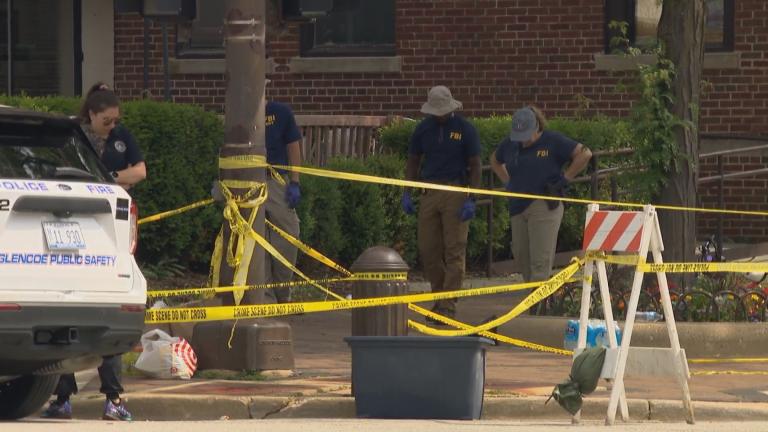Michael Matthews was sleeping in his brother's basement early one November morning. He had no idea the Cook County sheriff's office thought he was somewhere else — and that he would soon be sent to jail for it.
Matthews says he never left his brother’s basement in Hazel Crest without prior authorization — and says he has video evidence of himself inside at the time of some of the allegations. But he was reincarcerated at Cook County Jail in December, when a sheriff’s report, citing GPS data from his ankle bracelet, indicated he had left the residence 15 times.
On Wednesday, an assistant Cook County state’s attorney said in court there is evidence that “directly contradicts” the allegations that Matthews violated his home confinement and asked that he be allowed to return to a family member’s home on electronic monitoring. Matthews, his attorney said, needlessly spent more than three months locked up in Cook County Jail.
Matthews’ release from jail and return to electronic monitoring came after reporters with the DePaul Center for Journalism Integrity & Excellence began reporting on his case and filed a Freedom of Information Act request with the sheriff’s office for public records.
At the time, Matthews, a former city employee and father of six, was among the 2,500 people in Cook County awaiting trial on the sheriff’s electronic monitoring program. Electronic monitoring is a system through which the Cook County sheriff’s office tracks people awaiting trial using a GPS-based ankle bracelet. Some in the legal justice field have raised concerns about the technology’s ability to accurately track participants’ whereabouts — especially in some indoor and urban settings.
According to Matthews and his attorney, Tracey Harkins, the 15 alleged violations came after months of issues with his ankle monitor alerting authorities he had left his residence while he was at home.
“When I got alerted the first time, I talked with dispatch, and I thought it was maybe a small issue,” Matthews said. “Well, it happened two more times. So, at that point, I contacted my lawyer and I say, ‘Hey, I’m having some kind of issues where I’m home [and] I’m getting alerts.”
Matthews faces seven charges, including murder, in connection with a shooting outside of a River North nightclub in 2019. He has never been convicted of a crime. Prior to his arrest, he lived in North Lawndale with his family and operated a nonprofit called Endless Energy Sports that taught kids basketball as a means to stay out of trouble.
“A lot of people are suffering because of my situation,” Matthews said. “My family leaned on me … I was the bulk of the financial portion of our household. My wife has to work midnights just so she can be available to … [the] children. She’s mentally drained out from working 12-hour, night shifts, trying to pay the bills, keep the lights and everything on.”
A pattern of problems
“This one case is not an anomaly,” said Radiance Ward, a Cook County assistant public defender who represents people on electronic monitoring. “It is something that happens enough where we need to address it.”
Ward and her colleagues at the public defenders’ office have represented defendants experiencing issues with their ankle monitors alerting authorities while they are within their homes, often risking reincarceration or disruption to their daily lives. Ward, however, has no affiliation with Matthews’ case.
“The responsibility is on us as the defense attorney, or on the client, to show that they were indeed in the home,” Ward said.
After allegations of Matthews tampering with his ankle monitor, his brother, Walter, decided to take matters into his own hands.
“We decided to get a camera and put a camera in the basement to monitor, to make sure that any event that they call against him, that he wasn’t home, that he’d be able to prove that he was home,” Walter Matthews said.
Matthews said he tried to stay in view of the lens at all times, even sleeping on a recliner chair.
“The only time that I left from the front of the camera was to take a shower and use the washroom,” Matthews said in a Zoom interview from Cook County Jail.
The camera captured time-stamped footage of Matthews in the basement for seven of the 15 alleged violations. At the time of two of the alleged violations, Matthews is seen on his laptop, inches from the camera. During the time of another, a Wednesday afternoon, he is running on a treadmill. During one, Nov. 17 from 3:39 a.m. to 4:09 a.m., he is asleep in his recliner.
Matthews’ home camera system automatically deletes footage after 30 days.
“If Michael Matthews had been afforded the opportunity and been put on reasonable notice that the state and the Cook County sheriff’s office were going to make these allegations against him, he would have been able to provide [additional] footage,” Harkins said.
At a Cook County Circuit Court hearing in December, Judge Peggy Chiampas revoked Matthews’ bond and he was sent back to jail. Harkins asserts that she presented the videos that showed Matthews at home at the time of the violations to the court. But Chiampas, Harkins said, refused to view them before ordering Matthews back into custody.
A court spokesperson said Chiampas is prohibited from commenting on pending cases.
Reliance on GPS technology
In the county’s electronic monitoring program administered by Cook County Sheriff Tom Dart’s office, defendants wear an ankle monitor equipped with GPS and cellular tower tracking technology which alerts authorities when its wearer moves outside of their permitted boundary.
“The system itself, it alerts us when people move … And then when there is a movement that they’re not supposed to do, we contact people to see if there’s a reasonable explanation. If not, then we send cars over there,” Dart said at an event with Illinois state Sen. Sara Feigenholtz on Facebook Live in January.
Sheriff’s deputies suspected Matthews of tampering with his ankle monitor and issued him a written warning on July 14. Deputies tested Matthews’ ankle monitor in the basement of his brother’s home and determined it was working properly, according to Cook County sheriff’s documents obtained through a public records request.
“That seemed to form a basis of legitimacy for the allegations, in the mind of the state as well as the sheriff,” Harkins said.
One alleged violation, on Nov. 9, during which Matthews is captured on home video footage on his laptop, places him darting between his brother’s home, neighboring addresses and houses across the subdivision between 1:33 and 1:46 a.m.
“The addresses may reflect his host site address; however, the GPS device places him outside of his residence,” reads the entry on Matthews’ electronic monitoring progress report from this date, obtained from a public records request to the Cook County sheriff’s office.
Ankle monitors rely on GPS and cell tower technology to determine if its wearer’s location is within the range mandated by the court. Urban and indoor areas can interfere with the technology, affecting its ability to pinpoint the bracelet’s exact location.
“The analogy I use is if you’re ever trying to get directions, when you’re coming out of the grocery store, or the shopping mall, and you’re parked in a parking garage or an underground structure, the map is going to have no idea where you are,” said Jordan Boulger, executive assistant for administration and research with the Cook County Adult Probation Department. “So, there are known situations where GPS can be a little unreliable.”
Track Group, the company contracted by Cook County to provide ankle bracelets and examine alerts from the devices, has provided these devices to Cook County since 2017. Their products are marketed as a “reliable location tracking device,” as stated on their website. Track Group declined to comment, deferring to the Cook County sheriff’s office.
“The Sheriff’s Office utilizes the latest GPS technology available. Of course, we understand that GPS technology is not always 100% accurate,” Dart said in a statement to CJIE. “That is why we ensure staff are appropriately trained, and we employ a review system to account for the potential for technology problems.”
Dart added that staff who review issues with the electronic monitors are trained to differentiate between the issues with the technology and when there could be a potential violation.
With its known limitations, Cassie Follett, DePaul University’s geographic information systems coordinator, contends that the most important aspect of GPS tracking is interpreting the device’s data, including watching for signs of GPS drift.
“There are not technologies mature enough for indoor tracking for legal use,” Follett said.
Follett examined Matthews’ alleged movements on Oct. 5, which show him traveling across the street, through the backyard of a neighboring home and back to his brother’s house within four minutes. She said the signal quality data — coupled with the distance and time period — seemed to show a drift in his GPS tracking.
“For a brief second, it was acknowledged to be a lower quality, because it went from high to medium, it drifts,” Follet said.
The monitoring data reports the signal quality between the device and satellites as high, medium, or low. The first and final markers of this report, both near his brother’s house, show a high satellite signal, while the middle point – the furthest away from his brother’s house – fluctuates to a medium signal.
Follett said that the data in this instance shows the GPS signal correcting itself, placing Matthews back at his brother’s house.
Back in court
Ultimately, it is the judge’s decision to review documents from the sheriff and determine whether a defendant on electronic monitoring is sent back to jail. In court on Wednesday, when Matthews was returned to electronic monitoring, Judge Chiampas made her displeasure known when she emphatically said it is “not for individuals charged with murder.”
A judge’s decision in placing people on electronic monitoring is largely dependent on the defendant’s perceived risk level to the community, according to David Olson, co-director of the Center for Criminal Justice Research, Policy and Practice at Loyola University.
“Everything about the justice system in terms of decisions tends to be risk averse,” Olson said. “What do we do to minimize risk? Not only risk politically, to the elected officials who are responsible for these decisions, but risk to the community.”
The pretrial services division of the probation department conducts a public safety assessment on every person charged with a felony in Cook County. In doing so, the department assesses the defendant’s criminal history and conducts interviews to understand the context of their case. The whole assessment is then presented to a judge, the state’s attorney and the public defender.
“It’s a really tricky balancing act that the judges have to do, maintaining public safety while also protecting the rights of the defendant,” Boulger said.
In a statement released after Matthews was returned to electronic monitoring Wednesday, the sheriff’s office said it prioritizes public safety “in every aspect of its operations.”
“The court ordered Mr. Matthews to electronic monitoring for his murder case, and prosecutors requested information regarding his compliance on the program. The Sheriff’s Office provided comprehensive information regarding Mr. Matthews’ compliance. The state independently elected to proceed with a motion to revoke his bail, which they have now declined to pursue under their prosecutorial discretion,” the statement reads. “We will continue to work with Mr. Matthews to conform to the judge’s orders in this case as he is released back on electronic monitoring per the judge’s order for the underlying murder case. The Sheriff’s Office works hard to manage an electronic monitoring program with hundreds of defendants facing violent charges in a way that is accountable to the court, fair to the defendant and best promotes public safety.”
Matthews is clear that he is not looking for sympathy.
“I just want to get it right … I want to make sure it doesn’t happen to the next person,” he said in a February Zoom interview.
In court on Wednesday, he thanked the judge upon learning he will once again be placed on electronic monitoring. He will now go to live in the south suburbs with his sister and stay in a family room, and not a basement.







